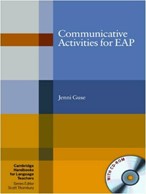Communicative activities for EAP by Jenni Guse, Cambridge handbooks for teachers
 Reviewed by Norman Cain, IH Rome Manzoni
Reviewed by Norman Cain, IH Rome Manzoni
In the introduction to her book Jenni Guse states she hopes to ‘provide communicative opportunities [for students] to notice, experiment with, analyse, produce and practice the language and skills that are essential to the study of English for Academic Purposes’ I must admit this was what interested me most about the book when I first saw it. The book also intrigued me as I know from speaking to less experienced EAP teachers that they are often not sure where to start when trying to teach EAP. Experienced colleagues say they want to make their EAP material communicative but find that doing so can be challenging and somewhat time-consuming. Luckily in her book Jenni Guse addresses both categories of teachers’ needs and provides us with a series of very well-prepared and easily adaptable, communicative lesson solutions.
The content of the book is clearly divided into six main areas, each area containing about 20 separate activities. Four of the chapters are dedicated to dealing with the four skills; reading, writing, listening and speaking, while two other areas cover Vocabulary development and Grammar.
The skills sections are subdivided following Freebody & Lake’s ‘Four Resources Model’ framework; that is, code user/breaker, text maker/text participant, text user and text agent/analyst. This framework offers teachers a range of activity types that help students to produce and receive meaningful language from a variety of authentic sources. Any teachers interested in knowing more about the four resources model, can consult a very clear and detailed outline framework given in the appendix.
The Vocabulary development and Grammar areas of the book are divided into noticing, experimenting and producing sections. Each section provides a series of very practical activities that can either be used as they stand in the book or can be applied to any text that the teacher already uses or a text that students have previously produced themselves. This way it gives students the chance to work on texts that are meaningful for them. The very clear and easily accessible framework Jenni Guse uses for the Vocabulary and Grammar areas, adapted from Teaching and Learning in the Language Classroom, (T. Hedge, OUP) can also be found in the appendix.
Without a doubt this book does exactly what it states on the cover. In all activities the focus is very much on student communication but Guse goes beyond just that. The tasks and activities she proposes mean that teachers provide their students, not just with more chances for communicative, but also opportunities for seeing the importance of authentic texts, promoting learner autonomy and opportunities to help students develop their own critical thinking and analytical skills.
At a very practical level each activity is clearly laid out from the start. A box tells the teacher the skill being dealt with, a syntactic outline of what the students will be doing, the level the activity is intended for, how much preparation is needed and the background to the task. The procedure is given in easy to follow steps and follow-up activities and ideas are often provided.
The meaningful topics Guse proposes are usually of an academic nature and the skills activities relate to those required at the tertiary level, for example, research skills, presentations and essay writing. Practice is also given in relevant areas such as note-taking, referencing and how to avoid plagiarism.
Many of the activities are printable from a CD-Rom that has been usefully provided at the back of the book and busy teachers will be pleased to know that for the majority of activities very little preparation is required. The book also includes useful exercises on concept mapping as well as how to use a visual thesaurus.
The activities range in level from intermediate level (defined by a star in the three-star grading system) and ends with fairly advanced material (three stars). For many of the activities covered, the teacher would ideally choose the actual text sources from websites; a useful source list is provided in the back of the book which means that the level of texts can easily be adjusted as needed.
One of the many strengths of Jenni Guse’s Communicative Activities for EAP is that teachers can dip into each section for ideas or to refresh their memories on a specific area without having to wade through the entire book. The book certainly provides some useful lesson ideas and outlines for practicing EAP teachers and is also an excellent buy for teachers who are not only working in EAP as many of the ideas could be used in a non EAP context.
Go out and buy the book! I would certainly recommend it.